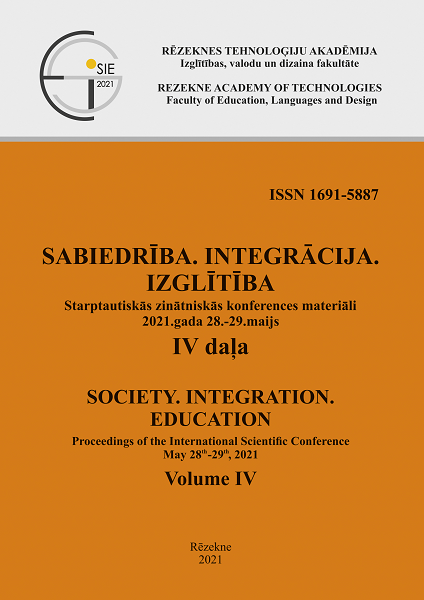OVERCOMING SOCIAL ISOLATION WITH DIGITAL TECHNOLOGIES AMONG AGEING POPULATIONS DURING COVID-19
DOI:
https://doi.org/10.17770/sie2021vol4.6356Keywords:
education level, gender, Latvia, network, Survey of Health, Ageing, and Retirement (SHARE)Abstract
During Covid-19 social isolation has become more common worldwide, however, some groups, especially elderly people, might have experienced dramatically limited communication due to the lack of skills and access to digital technologies. In this paper, we examined if education was associated with the use of digital technologies to maintain contacts with a family, friends, other social networks and services. The survey was conducted in June-August 2020 by doing 1089 computer-assisted telephone interviews. The questions examined how people aged 50 years and older coped with socioeconomic and health-related impact of COVID-19.
We used logistic regression analysis to study the association between the use of digital technologies and the level of education by gender and age. The higher the education was, the more it strongly associated with the use of digital technologies (OR 5.85; 95% CI 3.78-9.03). As expected, age was a strong explanatory factor, however, we did not find consistent age and gender differences. Among those who used digital technologies, analyses showed that overcoming social isolation was related to the education level. The conclusion of the study is that education has inevitable impact on the use of digital technologies and social contacts, however high education level is not crucial for the acquisition of information. It seems that digital technologies are important tools to prevent social isolation and are related to education that includes digital access and competencies.
References
Cacioppo, JT. & Cacioppo, S. (2014). Older adults reporting social isolation or loneliness show poorer cognitive function 4 years later. Evidence-Based Nursing, 17(2), 59-60.
Cacioppo, JT. & Cacioppo, S. (2018). The growing problem of loneliness. Lancet, 391(10119), 426.
Centers for Disease Control and Prevention. (2020). Older Adults at greater risk of requiring hospitalization or dying if diagnosed with COVID-19. Retrieved from https://www.cdc.gov/coronavirus/2019-ncov/need-extra-precautions/older-adults.html
Centre for Ageing Better. (2020). How has COVID-19 changed the landscape of digital inclusion? Retrieved from https://www.ageing-better.org.uk/sites/default/files/2020-08/landscape-covid-19-digital.pdf.
Hodge, H., Carson, D., Carson, D., Newman, L., and Garrett, J. (2017). Using Internet technologies in rural communities to access services: the views of older people and service providers. J. Rural Stud, 54, 469–478. DOI: 10.1016/j.jrurstud.2016.06.016
Martínez-Alcalá et al. (2018). Digital Inclusion in Older Adults: A Comparison Between Face-to-Face and Blended Digital Literacy Workshops. Front. ICT, 28 August 2018. DOI: https://doi.org/10.3389/fict.2018.00021
National Institute of Ageing. (2019). Social isolation, loneliness in older people pose health risks. United States Department of Health & Human Services. Retrieved from https://www.nia.nih.gov/news/social-isolation-loneliness-older-people-pose-health-risks.
The Survey of Health, Ageing and Retirement in Europe. (2021). [SHARE] Retrieved from share-project.org.
Seifert, A, Cotten, S.R., and Xie, B. A. (2020). Double Burden of Exclusion? Digital and Social Exclusion of Older Adults in Times of COVID-19. Journals of Gerontology: Social Sciences cite as: J Gerontol B Psychol Sci Soc Sci, Vol. XX, No. XX, 1–5.
DOI:10.1093/geronb/gbaa098 Advance Access publication July 16, 2020.
Tam, M. (2018). Lifelong learning for older adults: culture and confucianism, in The Palgrave International Handbook on Adult and Lifelong Education and Learning. London: Palgrave Macmillan, 857–878.






